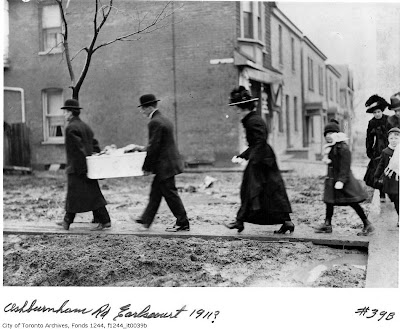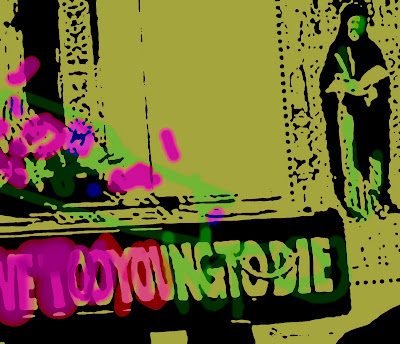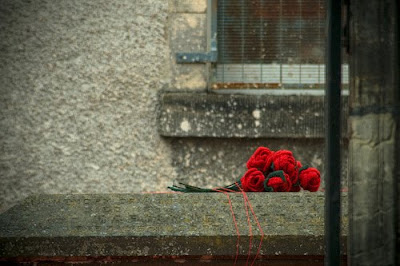
Toronto Funeral circa 1911
"My goal is to do to funeral services what midwives did to the Birth process: to bring it back home. To give it back to families, empowering them and creating the opportunity for a more profound experience. The truth is, our skills will always be required, but how we deliver them needs to be re-thought." -Kory McGrath

In her book 'The Death and Life of Great American Cities, Jane Jacobs pointed out the positive influence that Funeral Homes, Cemeteries, an even Undertakers can have on the life of urban neighborhoods.

Kory McGrath: At a young age I worked in a family-owned funeral home in a mid-sized city, then interned at a more rural funeral home a year or 2 later. It led to becoming enrolled in
woman I hold in high regard, and in another way to really start the dialogue on how death, funerals, grief, and memorialization work in a metropolitan landscape where everything else moves at such an exponential pace, and how they could provide more meaning - in a really profound way - for people directly involved and for people just passing by.
Pat McNally: Jane Jacobs noted the importance of having funeral homes and cemeteries as a part of the urban landscape. Do you think that these people and institutions contribute to a neighborhood?
Pat McNally: The visibility of funeral homes in urban areas has decreased quite a bit in many North American Cities. Certainly this has affected the neighborhoods. Do you think that this move away from the neighborhoods has affected funeral directors as well? Are they less in tune with their clients because of this change?
I also believe funeral directors are affected when the only work experience they have are with these larger corporate-style funeral firms that generally pop-up outside the city after having bought-up all the 'mom-and-pop' city parlours and where they are assigned tasks based on their best strengths - say a strong sales person only gets to engage in the funeral arrangement, and an apprentice only gets to be in the embalming room. Though seemingly more efficient, it doesn't equip a professional with the full spectrum of skills required to wholly serve families and typecasts them into one role which is detrimental if they ever wish to advance themselves. Not to mention the disconnected services provided to the family who get shuffled from person to person for each area of 'the transaction.'
On the other hand, many funeral homes migrate from the city to follow the ethnic or religious communities they have been serving for generations, so to the business, perhaps it is a matter of survival to pick up and leave town, rather than remain and adapt to the change. So in a way, these funeral directors are loyal to the families they serve, but not to the neighbourhoods they operate from. And I think that is a bit unfortunate - because they avoid ever having to change the way they conduct business, they just keep doing "what they've always done," which isn't always best for the consumer.

Pat McNally: What is your goal in this project?
Kory McGrath: Mostly to start a dialogue. To get people thinking about
funeral homes, funeral directors, death, grief, memorials and
listening to people talk about their personal experiences and any of
their own interactions in these areas and their ideas on what they
think is required in order for funeral professionals, funeral
storefronts, and memorial businesses to remain relevant to our
changing society. The thing is, 9 out of 10 people I've encountered in
my lifetime of being a funeral director still have this idea that it
is a grisly trade, that they hate funerals, that they think the
funeral industry is out to rob people, and so on.
I just believe there is so much potential that is not being explored - and it's generally
our fault - funeral directors get stuck in this script or hold onto
the traits of their forefathers - and all of those business practices,
especially in the urban setting, have for the most part expired. Why
aren't we encouraging families to have more input, to be more
participatory? Why aren't we walking alongside them in their journey,
not 'directing' it. Why are we resilient to the greening of our
industry? We should be leading it.
So I suppose, in a nutshell, my goal is to do to funeral services what
midwives did to the Birth process: to bring it back home. To give it
back to families, empowering them and creating the opportunity for a
more profound experience. The truth is, our skills will always be
required, but how we deliver them needs to be re-thought.
Pat McNally: I couldn't agree more! As funeral directors, we need to
encourage and facilitate more participation from the families we
serve. The movements toward green funerals and home funerals could
gain a lot if funeral directors engaged in the dialog and helped to
facilitate the changing desires and values of families interested in
these experiences. As an industry, we really do need to rethink how we
deliver our services and share our expertise. Mostly, I think, we need
to listen to what families and communities are saying, and respond in
a creative and compassionate manner. Funeral service is all about
relationships, and if we've lost touch with our communities, those
relationships need to be repaired.

Funeral Procession
Pat McNally: How can others get involved?
Kory McGrath: Most obviously, I'd encourage people to "Get Out and Walk" and discover the history and personalities that abound in their own neighbourhoods, talk to fellow civilians, ask questions and share stories and insights. Funeral professionals around the World could get more involved by emulating a similar walk where they live or holding a 'Doors Open' type of event at their workplace, inviting people to interact with the business at a time that is neutral in their lives - not just when they are in need of funeral services. I would also say that every funeral and non-funeral person needs to watch the film Departures.
Jane's Walk is in its 4th year in
Pat McNally: Is there a way to remedy the situation, bringing these influences back into neighborhoods? How can we adapt to the new landscape in a positive and creative way as individuals, neighborhoods, funeral service providers?
Kory McGrath: We are always having to reinvent ourselves - An editor for a gardening magazine becomes a gardening consultant or designer when they are laid off because no one buys magazines anymore. Furniture makers became undertakers when communities needed someone to make coffins for them, and later became morticians that offered embalming services. But now, I believe we have to think outside of bricks-and-mortar. There are many meaningful and creative ways to influence neighbourhoods without a storefront, or, by using "New ideas in old Buildings" (Jane Jacobs). I'll leave that to your imagination.
.jpg)
Archival Funeral Home Receipt
Pat McNally: Any parting thoughts or observations?
























